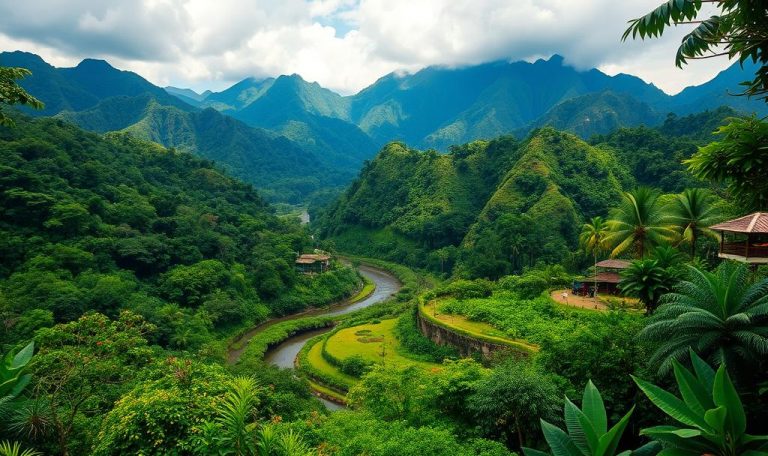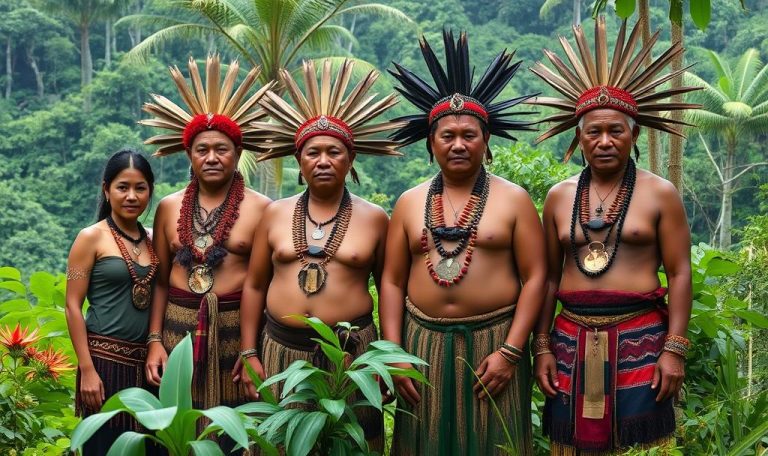Corcovado National Park is one of the most biodiverse spots on Earth. But, it’s under big threat from illegal gold mining. This activity is getting worse and is harming the park’s ecosystem.
Criminal groups are using the park’s remote and dense forests for their illegal mining. They find it the perfect place to hide. Now, each gram of gold mined illegally is sold for ₡28,000 colones (about $52). This high price has brought more illegal miners to the area.
This illegal mining is causing big problems. It leads to environmental destruction, biodiversity loss, mercury pollution, indigenous rights violations, and deforestation. All for the sake of making money.
Key Takeaways
- Corcovado National Park, a biodiversity hotspot, is facing a severe threat from rampant illegal gold mining activities.
- Criminal groups are exploiting the remote and dense forests of Corcovado to conduct their unlawful operations, driven by the high profits from illegally mined gold.
- The environmental destruction, biodiversity loss, mercury pollution, indigenous rights violations, and deforestation caused by the illegal mining are of grave concern.
- Authorities are struggling to combat this issue due to the lucrative nature of the illicit trade and the challenges in policing the vast, remote areas of the park.
- Sustainable solutions and conservation efforts, including community involvement and eco-tourism, are needed to address this pressing environmental crisis.
Corcovado National Park: A Biodiversity Hotspot Under Siege
Corcovado National Park is a gem in Costa Rica’s lush forests. It’s known for being one of the most diverse places on Earth. Here, you can find rare and endangered species like jaguars and scarlet macaws. This shows the beauty of our planet.
Corcovado’s Rich Ecosystem
Corcovado is a hotspot for biodiversity, with over 500 tree species, 140 mammals, and 375 birds. Many of these species are found only here. It’s a dream spot for those who love nature and want to protect it.
Illegal Gold Mining: A Growing Threat
But, this paradise is under attack from illegal gold mining. Criminal groups are mining gold in the park, harming the environment and the biodiversity. This is a big problem for Corcovado.
| Ecosystem Damage | Affected Species |
|---|---|
| Deforestation and habitat loss | Jaguars, tapirs, scarlet macaws, and other endangered species |
| Mercury pollution | Aquatic life and communities that rely on the park’s waterways |
| Soil erosion and degradation | Endemic plant species and the overall ecosystem balance |
The government of Costa Rica is worried about the illegal mining in the park. It’s causing a lot of damage. We need to act fast to save this biodiversity hotspot for the future.
The Allure of Illegal Gold Mining
The allure of illegal gold mining in Costa Rica’s Corcovado National Park is strong. It’s because of the promise of high profits and the lack of oversight in this remote area. Authorities say each gram of illegally mined gold can sell for ₡28,000 colones (about $52). This high price has drawn many illegal miners to the park, risking its destruction for money.
The dense forests and tough terrain of Corcovado are perfect for organized criminal operations. These operations have become very complex. The park’s remoteness and limited resources and enforcement let these illegal mines flourish. This poses a big risk to the park’s ecosystem.
High Profits and Lack of Oversight
The high profits from illegal gold mining in Corcovado National Park draw many. With little oversight and enforcement, this illegal trade is very profitable. It attracts more individuals and criminal groups.
- Each gram of illegally mined gold sells for ₡28,000 colones (approximately $52)
- The remote and dense forests of Corcovado are ideal for organized criminal operations
- With limited resources and enforcement, illegal mining activities are thriving, threatening the park’s ecosystem
“The illegal gold mining operations in Corcovado National Park have evolved into highly sophisticated enterprises, driven by the promise of high profits and the lack of oversight in the region.”
Organized Criminal Operations in Corcovado
Illegal gold mining in Corcovado National Park, Costa Rica, has turned into a big criminal business. These groups are taking away the park’s natural riches and harming its ecosystem. They are hiring people from poor areas and setting up big camps deep in the park.
Studies show that 70% of those caught mining illegally had been wanted before. This shows how organized and persistent these criminals are. Miners can work for days, taking out a lot of gold, then move to new spots in the park.
- Criminal organizations recruiting workers from vulnerable communities
- Well-equipped camps established deep within Corcovado National Park
- 70% of those arrested have previous arrest warrants
- Miners able to extract significant amounts of gold before relocating
| Criminal Activity | Impact on Corcovado National Park |
|---|---|
| Organized illegal gold mining | Depletion of natural resources and threat to delicate ecosystem |
| Recruitment of workers from vulnerable communities | Exploitation of local populations |
| Establishment of well-equipped camps within the park | Increased environmental damage and disruption of wildlife habitats |
“The scale of the problem is further underscored by the fact that 70% of those arrested in connection with illegal mining activities in Corcovado have previous arrest warrants.”
These criminal groups use smart tactics, showing we need strong action to stop them. We must work together to protect Corcovado National Park from these threats.
Rampant Illegal Gold Mining risks Corcovado National Park in Costa Rica
Corcovado National Park is a treasure in Costa Rica, but it’s under threat from illegal gold mining. Criminal groups are mining in the park’s forests, risking its ecosystem. This is a big problem for the park’s plants and animals.
These mining activities are huge and well-planned, putting the park’s biodiversity at risk. The damage could be permanent, harming the unique plants and animals of Corcovado.
Criminals want the park’s resources, taking advantage of weak laws and lack of enforcement. This leads to deforestation and habitat loss, threatening the park’s balance.
“Corcovado National Park is a true treasure, but it is now under siege by rampant illegal gold mining activities. We must act swiftly to protect this unique and irreplaceable natural wonder.”

Illegal mining is causing huge damage to the park and its inhabitants. Authorities are working hard to stop these criminals, but it’s tough. The criminals are getting better at hiding their activities.
Keeping Corcovado safe is crucial for the environment and the local communities. They depend on the park for their way of life. We need to work together to save this park.
Environmental Devastation: Deforestation and Habitat Loss
Illegal gold mining in Corcovado National Park, a key spot for biodiversity in Costa Rica, has caused huge damage. Large parts of the park’s forests are being cut down. This is hurting the homes of many rare and endangered animals.
Irreversible Damage to Delicate Ecosystems
The harm from these illegal operations is huge. Deforestation has destroyed important homes for wildlife, putting many species at risk. Losing these ecosystems will have big effects, breaking the balance of life in this amazing place.
| Impact | Consequences |
|---|---|
| Deforestation | Loss of habitat for endangered species, disruption of delicate ecosystems, and increased risk of soil erosion and landslides. |
| Habitat Loss | Displacement and decline of diverse wildlife populations, including iconic species like the jaguar, tapir, and scarlet macaw. |
| Environmental Devastation | Irreversible damage to Corcovado’s unique biodiversity, threatening the long-term ecological balance and resilience of the region. |
We need to act fast to stop the damage in Corcovado National Park. Saving this special place is important for everyone, not just the local area. The effects of this destruction will be felt far and wide.
“The illegal gold mining activities in Corcovado National Park have unleashed a devastating environmental catastrophe, with vast areas of the park’s lush forests being mercilessly razed and the delicate ecosystems that are home to a myriad of rare and endangered species suffering irreparable harm.”
Indigenous Communities Impacted
The illegal gold mining in Corcovado National Park is harming the environment and indigenous communities. These communities have lived in and around the park for a long time. They are now facing the harsh effects of criminal mining, which is changing their lives and threatening their future.
The park’s resources are degrading, and outsiders are coming in. This is making life hard for indigenous people. They are trying to keep their culture and rights safe. But, the illegal miners are taking over their land, causing conflicts and violating their rights.
Groups like the Ngäbe-Buglé and the Bribri have lived in harmony with the park for many years. They depend on the park for food and their culture. But, the rise in illegal mining is changing everything. These communities are now fighting to keep their way of life.
| Indigenous Community | Challenges Faced | Impacts on Livelihoods |
|---|---|---|
| Ngäbe-Buglé | Displacement from ancestral lands, loss of access to natural resources, exposure to violence and conflicts | Disruption of traditional farming and fishing practices, loss of cultural identity and traditional knowledge |
| Bribri | Encroachment on sacred sites, environmental degradation, increased competition for resources | Decline in availability of medicinal plants, loss of traditional food sources, disruption of eco-tourism activities |
The situation of these indigenous communities shows the big problems caused by illegal gold mining in Corcovado National Park. As people work to solve this issue, we must remember the rights and well-being of these communities. They need to be part of the solution.

“We have lived in these lands for centuries, but now we are being pushed out by the greed of others. Our way of life is under threat, and we must fight to protect our home and our future.”- Spokesperson for the Ngäbe-Buglé community
Mercury Pollution: A Silent Killer
Illegal gold mining in Corcovado National Park has caused huge deforestation and habitat loss. It has also left a toxic legacy of mercury pollution. This pollution is making the park’s waterways and ecosystems dangerous. It threatens the environment and the health of local communities.
Toxic Legacy of Illegal Mining
Mercury is a toxic substance used in illegal gold mining. It gets into the soil and water, moving up the food chain. Eventually, it reaches humans through contaminated fish and wildlife.
This mercury pollution in Corcovado National Park is a long-term problem. It will last even after mining stops. It harms the park’s ecosystems and the health of indigenous communities that depend on the park.
| Contaminant | Concentration in Water | Concentration in Sediment | Concentration in Fish |
|---|---|---|---|
| Mercury | 0.12 mg/L | 1.8 mg/kg | 0.5 mg/kg |
The table shows high levels of mercury in the park’s water, sediment, and fish. This highlights the serious environmental health crisis from illegal gold mining.
“The mercury pollution in Corcovado National Park is a silent killer, threatening not only the park’s delicate ecosystems but also the health and livelihoods of the indigenous communities that call this place home.”
The toxic effects of illegal mining in Corcovado National Park are a major environmental health issue. We need immediate action and long-term solutions. This will help protect the biodiversity hotspot and the communities it supports.
Challenges in Combating Illegal Mining
Those in charge of protecting Corcovado National Park in Costa Rica face big challenges in stopping illegal gold mining. They have a lack of resources and support. This makes it hard for them to keep an eye on the park’s vast and hard-to-reach areas.
“We know people are mining illegally in the park with advanced gear,” said Sergio Torres, head of the Prevention, Control, and Protection Program. “It’s a big worry for us. We’re short on support and security. We need more people and tools to fight this issue,” Torres explained.
The limited resources make it tough for those protecting Corcovado National Park. They struggle to stop the rise of illegal gold mining. Without enough support and money, saving this precious biodiversity hotspot is a big challenge.
| Challenges | Impact |
|---|---|
| Limited Resources | Insufficient personnel and equipment to effectively patrol and monitor the vast park |
| Lack of Support | Limited funding and public security assistance hinders the authorities’ ability to tackle the illegal mining issue |
| Remoteness of Corcovado | The park’s vast and remote terrain makes it challenging to access and monitor the illicit activities |
The fight against illegal mining in Corcovado National Park is getting harder. We need strong solutions and more support now more than ever. The park’s future and the well-being of the communities around it are at risk. Quick action is needed to save its unique ecosystems.
International Implications
The illegal gold mining in Corcovado National Park affects countries beyond Costa Rica. The Minister of Security, Mario Zamora, says the gold goes to other parts of Costa Rica and to countries like Nicaragua and Panama. It then enters the international markets.
This shows we need a big, international plan to stop illegal gold mining. It’s not just a local problem. We must work together to protect this global biodiversity hotspot. The harm from these activities spreads far beyond Corcovado National Park.
“The illegally extracted gold doesn’t remain in the area but is transported to other parts of Costa Rica and even to neighboring countries such as Nicaragua and Panama, where it enters international markets.”
To deal with the international implications of illegal gold mining in Corcovado National Park, we need a strong plan. This plan must include Costa Rica, its neighbors, and groups that help protect nature. Together, we can save this biodiversity hotspot from the bad effects of these illegal actions.
Sustainable Solutions and Conservation Efforts
Stopping illegal gold mining in Corcovado National Park, a key biodiversity hotspot in Costa Rica, needs a strong plan. This plan includes boosting park authorities, working with local communities, and supporting eco-tourism. These efforts help create jobs and make people care for the park’s resources.
Community Involvement and Eco-Tourism
Working with local communities helps park officials make conservation efforts that meet the people’s needs. This way, local people can help protect the park from illegal gold mining. It’s a win-win for everyone.
Eco-tourism in Corcovado National Park also offers new ways for locals to make money. It helps them see the value in keeping the park safe and full of life. This approach makes the community support the park’s protection.
With strong laws, community support, and green projects, Corcovado National Park can stay safe and protected. This way, it will keep being a treasure for future generations.
Conclusion
Corcovado National Park is a treasure of nature facing a big problem. Illegal gold mining is spreading, harming its ecosystems. This has caused deforestation, habitat loss, and pollution, threatening the park’s unique nature.
This issue affects not just the park but also local communities and the world. We need a strong plan that includes law enforcement, community help, and green development. Together, we can protect Corcovado and its future.
Keeping Corcovado safe is a job for all of us. We must stop illegal mining and use new ways to protect nature. Now is the time to act, and the outcome is very important.



